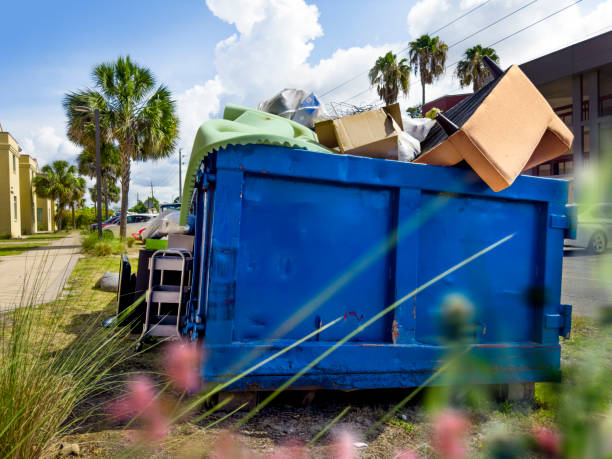Choosing the right dumpster size for your project is a critical decision that can save you time, money, and hassle. Whether you’re embarking on a home renovation, clearing out clutter, or managing debris from a construction site, having the proper dumpster size ensures an efficient and cost-effective waste management solution. This guide will walk you through everything you need to know to choose the right dumpster size, including how dumpsters are measured, typical project requirements, and some key tips for making the best choice.
1. Understand How Dumpster Sizes are Measured
Dumpsters are measured in cubic yards, which refer to the volume of space they provide. One cubic yard equals a three-foot by three-foot by three-foot area, or 27 cubic feet. Dumpster sizes typically range from 10 to 40 cubic yards, but some companies also offer smaller or larger sizes depending on regional demand and availability. Here are the most common sizes and their approximate dimensions:
- 10-Yard Dumpster: 10 ft long x 7 ft wide x 4 ft high
- 20-Yard Dumpster: 22 ft long x 7.5 ft wide x 4.5 ft high
- 30-Yard Dumpster: 22 ft long x 7.5 ft wide x 6 ft high
- 40-Yard Dumpster: 22 ft long x 7.5 ft wide x 8 ft high
It’s important to keep in mind that these dimensions vary slightly among rental companies. Knowing the size in cubic yards, though, will give you a general idea of the dumpster’s capacity and what it can accommodate.
2. Identify Your Project Type and Waste Volume
Each project generates a different type and amount of waste, which plays a significant role in determining the right dumpster size. Below are some common projects and the typical dumpster sizes suited to each.
Small Cleanouts and Minor Remodels (10-Yard Dumpster)
A 10-yard dumpster is often suitable for smaller projects, such as:
- Small room cleanouts (closet, attic, or garage)
- Minor bathroom or kitchen remodels
- Yard cleanups with light debris like branches or leaves
This size holds approximately 50-70 trash bags and is ideal for projects with minimal waste. It’s a great choice if you’re working with limited space on your property or have only a moderate amount of junk to clear.
Medium-Scale Renovations and Yard Cleanups (20-Yard Dumpster)
A 20-yard dumpster is among the most popular choices due to its versatility. This size is ideal for:
- Larger room cleanouts, like a basement or attic
- Kitchen or bathroom renovations
- Landscaping projects with heavier materials (soil, concrete, sod)
A 20-yard dumpster can handle around 110-130 trash bags, making it well-suited for medium-sized projects that produce a moderate to large amount of waste.
Large Home Remodels and Major Cleanouts (30-Yard Dumpster)
A 30-yard dumpster is suitable for larger projects, such as:
- Full home remodels or large renovation projects
- Roof replacements for houses with multiple layers of shingles
- Big landscaping or outdoor projects with lots of debris
This size provides ample room for approximately 170-190 trash bags, making it a good fit for projects that produce substantial waste volumes.
Construction and Demolition Projects (40-Yard Dumpster)
The largest standard option, a 40-yard dumpster, is designed for heavy-duty jobs like:
- Construction sites and demolition projects
- Major home additions or new constructions
- Large-scale decluttering or hoarder cleanouts
With a capacity of roughly 240-250 trash bags, this size accommodates substantial debris and bulk materials. However, ensure you have enough space for this size dumpster, as it’s quite large and requires ample room.
3. Consider the Type of Waste You’ll Be Disposing Of
The type of waste you’re discarding plays a big role in selecting the right dumpster. Here are a few things to consider:
- Heavy Materials: If you’re disposing of heavy items like concrete, bricks, dirt, or other dense materials, smaller dumpsters are often more practical and safer. For example, a 10-yard dumpster filled with concrete can be extremely heavy and potentially exceed the weight limits of a larger dumpster.
- Mixed Waste: For projects with a variety of waste types (e.g., furniture, yard debris, construction materials), you’ll need to assess the bulk and density of your waste to determine the best size. A 20- or 30-yard dumpster usually offers the flexibility needed for mixed waste.
- Hazardous Materials: Many rental companies have strict regulations on hazardous waste, which may include chemicals, electronics, or medical waste. Always consult with the rental provider about any restrictions, as these materials might require special disposal methods.
4. Estimate the Volume of Your Junk
While it can be difficult to precisely calculate the volume of waste, using some rough estimates can be helpful. One approach is to assess the number of rooms or spaces you’ll be clearing out and the volume of each:
- For example: A small room cleanout, like a bathroom, typically produces 1-2 cubic yards of debris. A larger area, like a living room or garage, might produce 4-8 cubic yards.
Another method is to visualize the number of pickup truck loads your project might create. On average, a pickup truck bed holds about 2-3 cubic yards of material, so you can use this measurement to approximate your needs.
5. Assess Available Space for the Dumpster
When choosing a dumpster size, make sure to assess the available space on your property or project site. Consider the following:
- Placement Options: Make sure you have adequate room to accommodate the dumpster on a driveway, street, or parking lot. Some neighborhoods have restrictions on street placement, so check local regulations or get any necessary permits.
- Accessibility: Ensure that the location allows easy access for filling the dumpster. If you’re placing it on a driveway or near your home, leave enough space to walk around it safely.
- Avoiding Damage: If placing a dumpster on a concrete or asphalt driveway, consider laying down plywood or boards to protect the surface from scratches or dents.
6. Understand Weight Limits and Disposal Restrictions
Most dumpster rental companies enforce weight limits for each dumpster size to ensure safe transport and compliance with local disposal laws. Here are some key things to keep in mind:
- Weight Limits: Heavier materials add up quickly, and exceeding weight limits can lead to overage charges. For example, a 10-yard dumpster for heavy debris like concrete might have a limit of 1-2 tons, while larger dumpsters used for lighter materials might allow up to 4-6 tons.
- Overage Fees: If you surpass the weight or fill limit, you may be charged additional fees. Knowing the limitations beforehand helps prevent unexpected costs.
- Prohibited Items: Many companies prohibit hazardous materials, tires, and certain electronics. Check with your rental provider for a complete list of restricted items to avoid fines or complications.
7. Seek Expert Advice
If you’re uncertain about the right dumpster size, don’t hesitate to consult with the rental provider. Many dumpster rental companies have knowledgeable staff who can offer guidance based on your specific project, waste type, and anticipated volume.
Additionally, if you anticipate needing multiple dumpsters or a long-term rental for an extended project, rental companies often offer flexible options and can recommend a tailored solution.
8. Consider Flexibility for Larger or Ongoing Projects
For larger or ongoing projects, consider arranging for “swap-out” service, where a rental company removes and replaces a full dumpster with an empty one. This approach is efficient and minimizes project delays, ensuring a continuous waste disposal solution without the need to overestimate the initial dumpster size.
Conclusion
Choosing the right dumpster size for your project is essential for efficient waste disposal and cost control. By understanding dumpster sizes, assessing your project type, and taking weight and disposal restrictions into account, you can make an informed decision that best suits your needs. Whether you’re tackling a small home cleanout or managing debris from a large construction site, selecting the appropriate dumpster size helps streamline your project and keeps waste management hassle-free.
For those unsure of where to start, consulting a dumpster rental company is a wise move. They can provide expert advice tailored to your project, ensuring you get the right size dumpster and avoid unnecessary expenses. With careful planning and the right dumpster size, you’ll be well-prepared to tackle any project efficiently and effectively.



